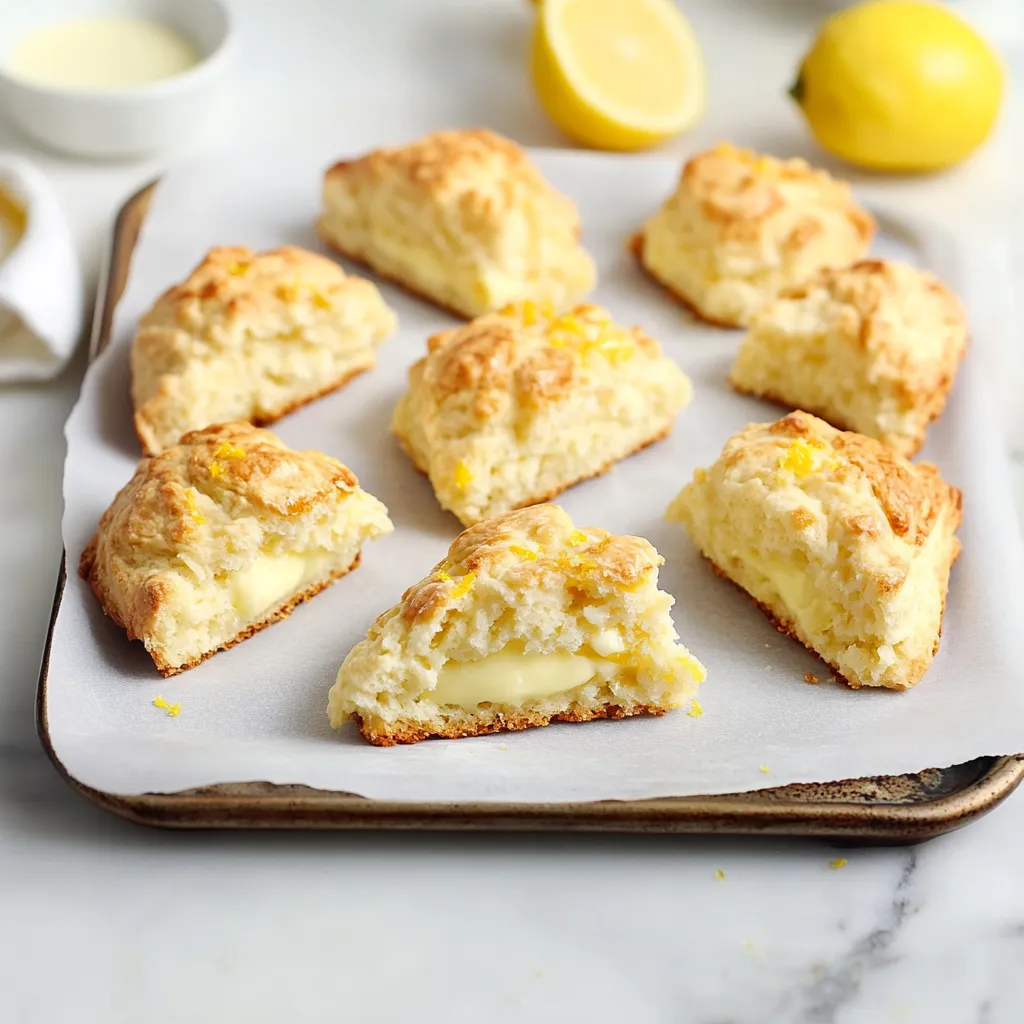 Pin it
Pin it
These buttery lemon scones bring a ray of sunshine to your breakfast table - with soft, flaky layers soaked in vibrant citrus flavor and topped with a zesty drizzle. After countless tries to get scones just right, I've found that making these citrus treats comes down to balancing temperatures, methods, and timing correctly. Every time I bake them, I learn something new about making great pastry.
I made these for a family get-together last Sunday, and everyone smiled after their first taste. What's my trick? Knowing how ice-cold butter and fresh lemons work together for the best texture and taste.
Key Ingredients and Shopping Advice
- Butter: Try to get European butter if you can, as its higher fat makes your scones flakier.
- Lemons: Look for bright yellow, heavy fruits with smooth, thin peels for more juice and better zest.
- Cream: Keep it in the fridge until you're ready to use it.
- Baking Powder: Check that it's not expired for the best rise.
 Pin it
Pin it
Detailed Instructions
- Getting the Lemon Ready:
- Grab the zest before juicing, using gentle motions to avoid the bitter white part. Rub the zest into your sugar to pull out all the oils for stronger flavor.
- Watching Temperatures:
- Don't let your butter, cream, or eggs warm up. Pop butter cubes in the freezer for 15 minutes before you mix them in.
- Mixing Dry Stuff:
- Stir together flour, your lemon sugar mix, baking powder, and salt. Make sure everything's well combined with no lumps.
- Adding Butter:
- Cut the frozen butter into your dry mix using a pastry tool or your fingers until it looks like rough sand with some pea-sized butter bits left.
- Combining Wet Ingredients:
- Beat cream, egg, and vanilla until blended. Carefully fold this into your flour mixture just until the dough comes together.
- Forming Your Scones:
- Dump the dough onto a lightly floured counter, press it into an 8-inch round about 1-inch thick, then slice into 8 triangles.
 Pin it
Pin it
Before Baking Steps
Stick the shaped scones in the freezer for 15 minutes. Brush the tops with a bit of heavy cream, then bake at 400°F for 18-22 minutes, turning the pan around halfway to get even browning.
Making the Perfect Topping
- Getting Ready:
- Run powdered sugar through a sifter to break up clumps. Slowly mix in lemon juice until it's the thickness you want.
- Putting It On:
- Pour the topping over slightly cooled scones and wait 10 minutes for it to set. Add another layer if you'd like.
Tasty Changes to Try
- Toss in 1 cup fresh blueberries for a fruity twist.
- Stir in 2 tablespoons poppy seeds for some crunch.
- Swap lemon for orange or lime for different citrus flavors.
- Mix in dried cranberries for a tangy contrast.
Expert Baking Tricks
- Double-check your oven heat with a separate thermometer.
- Turn your baking sheet around halfway through cooking for even results.
- Get a dough scraper for easier handling.
- Keep some extra flour nearby for sticky situations.
Ways to Serve
- Enjoy with Earl Grey or English Breakfast tea.
- Put out some lemon curd on the side for extra flavor.
- Set them up on a fancy stand for brunches.
- Add some clotted cream as a traditional touch.
Fixing Common Problems
- If your dough feels too crumbly, add a splash more cream.
- For dough that's too sticky, sprinkle more flour on your work area.
- If they're browning unevenly, your oven might have hot spots.
- When the glaze is too thick, add tiny drops of lemon juice until smooth.
Best Teas to Serve Alongside
- Earl Grey works great with the citrus notes.
- English Breakfast makes a traditional pairing.
- Green tea gives a nice light balance.
- Chamomile works well for afternoon snacking.
Different Textures to Try For
- Get flaky layers by using the cold butter trick.
- Make a soft inside by not overworking the dough.
- Create crunchy tops with a cream wash before baking.
- Find the right glaze thickness so it sets properly.
Complex Flavor Ideas
- Mix in real vanilla seeds to complement the lemon.
- Try adding pure citrus oils for deeper flavor.
- Fresh herbs like thyme can work surprisingly well.
- Adjust how much zest you use based on how tangy you want them.
What Each Ingredient Does
- Butter creates those lovely flaky bits.
- Cream adds richness to the dough.
- Egg gives structure so they don't fall apart.
- Lemon adds that wake-up zing.
- Sugar balances out the tartness.
Baking Science Stuff
- Cold butter makes steam pockets as it melts.
- Baking powder works at specific times during baking.
- Limiting how much you mix controls the gluten.
- Sugar does more than sweeten—it makes them tender.
Making Memories
- They're great for lazy family Sunday mornings.
- Start a holiday morning tradition with these.
- Bake a batch to drop off to neighbors.
- Make them to mark special occasions.
Last Baking Tips
Go with your gut as you get better. Enjoy learning as you go. Be proud of small wins. Pass on what you learn to friends and family.
 Pin it
Pin it
History and Heritage
Scones started in Scotland but have become beloved treats worldwide. These lemon versions keep that tradition going while adding fresh, modern twists. Each time we bake them, we're part of this ongoing food story.
Adding Your Personal Style
You'll soon figure out your own way of making these scones. Maybe you'll tweak the lemon amount to match your taste. Or find your ideal glaze consistency. Perhaps change the baking time slightly. Or even create your own unique shape.
Baking as Self-Care
Making scones can actually be relaxing. Try to focus on each step without rushing. Notice how the ingredients change as you work. Find the joy in the process. Then share what you've made with people you care about.
Final Thoughts
Getting lemon scones just right happens when you understand how ingredients, temperature, and handling all work together. From many batches in my kitchen, I've learned that success isn't just about measuring things precisely but developing a feel for how the dough should be, what properly mixed butter looks like, and even recognizing that perfect baking smell when they're almost done.
Frequently Asked Questions
- → Why keep the ingredients cold?
- Chilled butter melts during baking, making airy, tender layers.
- → Is it okay to prep in advance?
- Sure! Freeze dough unbaked, then bake from frozen by adding a few more minutes.
- → What’s the purpose of chilling?
- Chilling firms up the dough so the scones hold their shape while rising.
- → What's a simple buttermilk swap?
- Stir 1 teaspoon of lemon juice into milk and set aside for 5 minutes.
- → How can you tell they’re done?
- Check for a golden top and light browning beneath, usually after 20 minutes.
